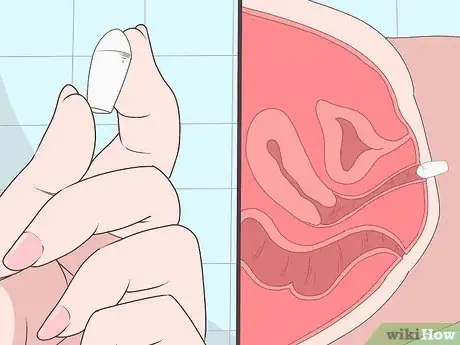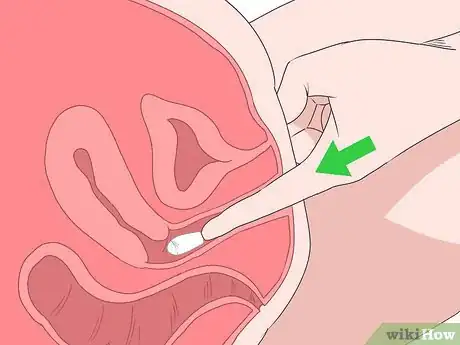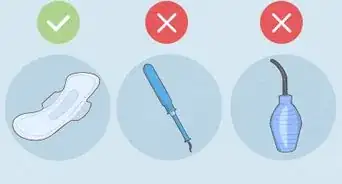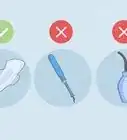This article was medically reviewed by Luba Lee, FNP-BC, MS and by wikiHow staff writer, Danielle Blinka, MA, MPA. Luba Lee, FNP-BC is a Board-Certified Family Nurse Practitioner (FNP) and educator in Tennessee with over a decade of clinical experience. Luba has certifications in Pediatric Advanced Life Support (PALS), Emergency Medicine, Advanced Cardiac Life Support (ACLS), Team Building, and Critical Care Nursing. She received her Master of Science in Nursing (MSN) from the University of Tennessee in 2006.
There are 10 references cited in this article, which can be found at the bottom of the page.
This article has been viewed 243,664 times.
Progesterone suppositories are often used during in vitro fertilization (IVF) treatments or to cause periods in perimenopausal women who are low in progesterone. The suppositories are made by a pharmacist and can be inserted either with or without an applicator. Make sure both your hands and vaginal area are clean before you insert your suppository. Follow all of your doctor’s instructions for using and storing your progesterone.
Steps
Washing Up
-
1Clean your vaginal area with unscented soap and warm water. Stand in your shower or bathtub, then wet your vaginal area. Use your hand or a clean wash cloth to apply the soap to your vagina. After you lather the soap, rinse it away with warm water until all of the soap is gone.
- Your vaginal area can harbor bacteria and germs. You need to wash the area to make sure these bacteria and germs don’t enter your vagina when you insert the suppository.
- Make sure your soap is unscented, as fragrances can cause irritation.[1]
-
2Wash your hands with soap and warm water. Wet your hands with warm water, then apply soap to them. Rub your hands together to create a lather, continuing for 20 seconds. Then, rinse your hands under warm running water until all of the soap is washed away.[2]
- Your hands can also have germs and bacteria on them, and you don't want to transfer any germs or bacteria into your vagina.
Advertisement -
3Be careful when handling the suppository because it can melt. Your suppository is made from progesterone suspended in a base. When it enters your body, the base melts and releases the progesterone. You don't want the suppository to melt in your warm hands, so handle it as little as possible.[3]
- It’s best to lightly hold your suppository between 2 fingers. Never hold it in your palm.
Pushing the Suppository into Your Vagina
-
1Lie on your bed with your bent knees pulled back toward your chest. This helps open your vagina as much as possible so it's easier to insert the suppository. You'll be able to push it in deeper than you would in other positions, which helps it be more effective.[4]
- Pull your legs as far back as possible, rather than just bending your knees.
-
2Place the suppository on the end of your finger. You may be able to get your suppository to stick to the end of your finger. If this doesn’t work, hold the suppository at the entrance to your vaginal canal. Then, put the tip of your finger behind it to push it into your vagina.
- Remember to use a light touch when handling the suppository, as it can easily melt in your hands.
-
3Push the suppository into your vagina as far as it will comfortably go. This will likely be as far as your finger will go, as well. If you feel any resistance, stop pushing and leave the suppository where it is.[5]
- You should not feel any pain or discomfort when you insert the suppository. If you do, stop pushing and remove your finger.
-
4Remove your finger from your vagina. Slide your finger out, leaving the suppository in place. Make sure you don’t remove any of the medicine when you pull out your finger.
- It's unlikely that the suppository will stay stuck to your finger. If this happens, however, re-insert the suppository into your vagina. Press against the side wall of your vagina to help it stick.
-
5Lower your legs back down onto the bed. Relax in a lying down position for a moment before getting up. The suppository will start melting immediately after you insert it into your vagina.
- You don't need to stay lying down after you insert the suppository.
-
6Wash your hands after handling the progesterone suppositories. Scrub your hands with soap for 20 seconds, then rinse them clean in warm, running water. This will prevent the progesterone from absorbing into the skin on your hands and fingers.[6]
Using Your Medicine as Directed
-
1Read all of the information included with your suppositories. Follow all of the instructions provided by your doctor and pharmacist. The instructions for using progesterone can vary depending on your individual needs, so do as your doctor directed.[7]
- Your suppositories should look like ovals or bullets. They’re usually prepared by the pharmacist, so check with them if you have any questions.
-
2Take a missed dose as soon as possible, unless your next dose is near. If you miss a dose of your progesterone, take it as soon as you remember. It’s important to take your medicine as directed, without missing a dose. However, don’t take two doses at once.[8]
- If it’s close to your next scheduled dose, skip the dose you forgot to take.
-
3Opt for loose fitting, breathable clothing while using the suppositories. The progesterone will keep your vaginal area moist, as it will slowly leak out of your vagina. Wear cotton panties and loose skirts or pants until you’re finished with your medication.
- While using vaginal progesterone, don’t wear tight pants, nylon panties, or tights. These materials don’t breathe, so they increase your risk of developing a yeast infection.[9]
-
4Wear a sanitary pad to protect your underwear from leakage. The suppository will melt inside your body and slowly leak out of your vagina. You can wear a sanitary pad to protect your underwear from the leakage.
- Remember to change your pad every few hours. You want to keep your vaginal area as dry as possible, which will help prevent a yeast infection.
- If you use your suppository right before bedtime, you will experience less discharge than if you walk around after you insert it.
-
5Do not wear tampons while using vaginal progesterone. Tampons can absorb the progesterone, which can limit how effective it is. Always use sanitary pads rather than tampons.[10]
- You might start your period while you’re using the progesterone. If this happens, continue to use sanitary pads only. Don’t use tampons.
-
6Store your suppositories in the refrigerator to keep them from melting. It’s best to store your suppositories in the cool, dry conditions in your refrigerator. This helps them hold their form and makes them easier to insert, as they can easily melt.[11]
- Some progesterone suppositories can be stored at room temperature. Check the label on your medication to be sure.
- Don’t freeze your suppositories.
-
7Talk to your doctor about the risks of taking progesterone. Although progesterone is considered safe, all medicines come with risks. Your doctor can help you understand how your personal medical history relates to the risks of taking progesterone. Here are some risks your doctor may discuss:[12]
- You shouldn't take progesterone during pregnancy unless it's prescribed as part of your fertility treatment.
- Progesterone can increase your risk of developing blood clots, stroke, heart attack, or breast cancer. This risk is greater if you have a personal or family history of these conditions.
Our Most Loved Articles & Quizzes
Warnings
- Never take your progesterone by mouth.⧼thumbs_response⧽
- If you do use an applicator, don’t reuse it unless it's labeled as reusable. Applicators are usually intended to be used once.⧼thumbs_response⧽
- Don’t use any other vaginal products while you’re taking progesterone suppositories, as they might make the medication ineffective.⧼thumbs_response⧽
- Progesterone can cause drowsiness. Don’t drive or use heavy machinery while taking the medicine. It’s a good idea to take it right before bedtime.⧼thumbs_response⧽
References
- ↑ https://uihc.org/health-topics/vulvar-skin-care-guidelines
- ↑ https://www.medicines.org.uk/emc/product/5569/pil
- ↑ https://www.drugs.com/mtm/progesterone-vaginal.html
- ↑ https://www.medicines.org.uk/emc/product/5569/pil
- ↑ https://medlineplus.gov/druginfo/meds/a688022.html#how
- ↑ https://medlineplus.gov/druginfo/meds/a688022.html#how
- ↑ https://www.uofmhealth.org/health-library/d00550t1
- ↑ https://www.drugs.com/cdi/progesterone-vaginal-insert.html
- ↑ https://myhealth.alberta.ca/Health/aftercareinformation/pages/conditions.aspx?hwid=uf7069
- ↑ https://www.uofmhealth.org/health-library/d03208a1
- ↑ https://my.clevelandclinic.org/health/drugs/18933-progesterone-vaginal-suppositories
- ↑ https://my.clevelandclinic.org/health/drugs/18933-progesterone-vaginal-suppositories
- ↑ https://myhealth.alberta.ca/Health/medications/Pages/conditions.aspx?hwid=fdb0975
About This Article
Progesterone suppositories are usually used during IVF treatment or to bring on your period. To insert one, you'll first need to wash your hands and your vaginal area with non-scented soap to reduce the risk of infection. Then, lie on your back with your legs up. Hold the suppository on the end of your fingers, but don’t hold it too long as it could melt. Push the suppository into your vagina as far as it will comfortably go. Afterwards, bring your legs back down and wash your hands. You should also wear a sanitary pad to catch any leakage. Choosing loose-fitting underwear is another good idea, since the suppository will keep your vaginal area moist. For tips from our Medical co-author on how to store your suppositories, read on!





























-Step-10-Version-2.webp)













































Medical Disclaimer
The content of this article is not intended to be a substitute for professional medical advice, examination, diagnosis, or treatment. You should always contact your doctor or other qualified healthcare professional before starting, changing, or stopping any kind of health treatment.
Read More...